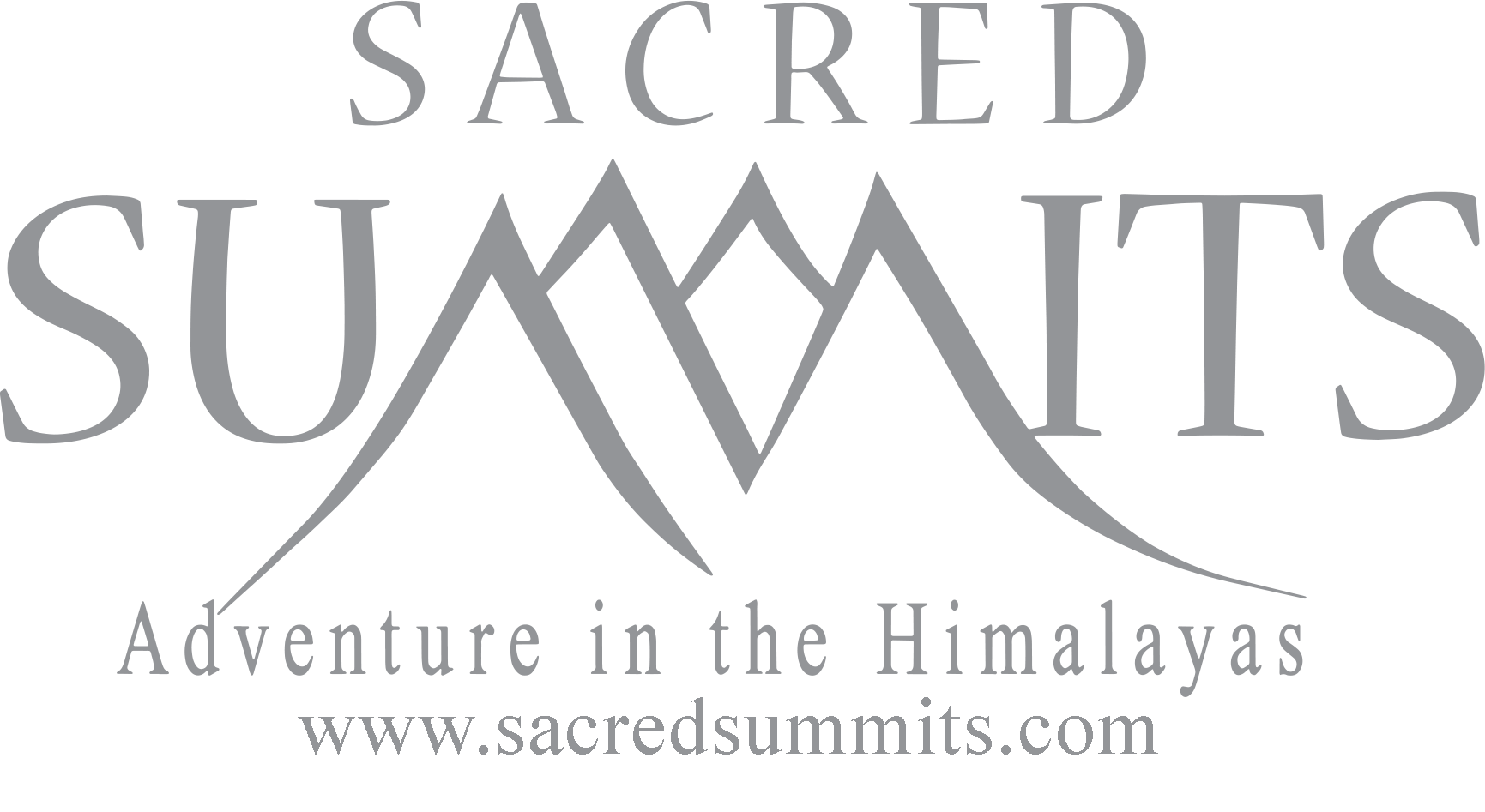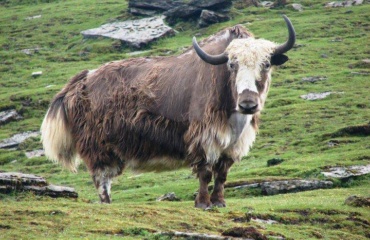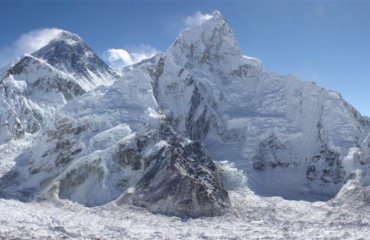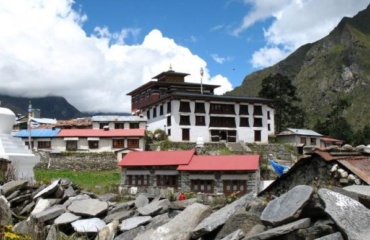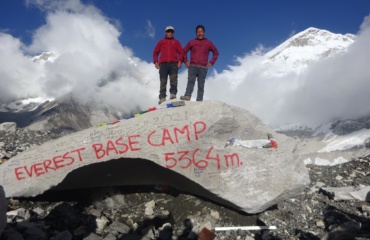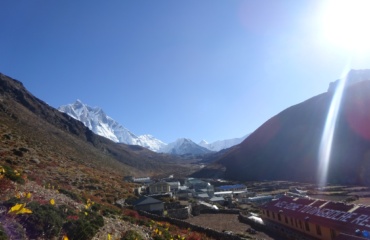EVEREST BASE CAMP TREK
The Everest Base Camp Trek takes one to the foothills of the mightiest of the mountains in the world. En-route, traverse through rhododendron and pine forests, rivers, Sherpa villages and Buddhist Monasteries from temperate to snow line regions. The Himalayas are best seen on this trek as one traces the main route through the Khumbu region from the Sherpa town of Namche Bazaar. Trekkers get a close view of the world’s greatest mountains, Everest, Lhotse, Nuptse, Thamserku, Tawache and others.
Located in the eastern half of Nepal, the Everest region offers a wide range of trekking experiences. From the well-developed trail to Everest base camp to treks in remote semi-wilderness areas, there is a choice to suit all-corners. The most frequented part of the region is located in Solukhumbu district, the home of the legendary Sherpa’s. The northern part of the district (Khumbu) is encompassed in the Everest National Park, which was established to protect the fragile environment of the alpine region.
Beside Mount Everest there are other 8,000 meter peaks in the region. Lhotse, Cho Oyu and Makalu and in addition numerous other peaks lesser altitude but no less stunning. Add to this glacial lakes rhododendron forest, native flora and fauna, traditional villages and ancient Buddhist monasteries, all go to make this region a spectacular destination.
People and Culture
The main ethnic group that visitors will encounter in the Everest region is the Sherpa’s. This is their heartland and their influence is to be seen everywhere from their traditional dress to their distinctive houses and village monasteries. There are also minorities of various other groups, notably Rai / Limbu and Tamang in the lower hills and the ubiquitous Brahmin and Chettris farmers of the valleys.
Flora and Fauna
The flora and fauna to be seen are quiet diverse since the region ranges in altitude from less than 2000 meters above sea level at Jiri to the high peaks of the Himalaya at over 8000 meters. Up to 4000 meters you will find dense stands of forest including pine, oak and the spectacular flowering rhododendrons. The latter are one reason to make a trip in Nepal in the spring when the hills between 2000 and 3500 meters are a riot of colors.
The crop under cultivation will depend on the season that you visit but expect to see wheat, barley, corn and potatoes at some stage. Domesticated animals will range from cattle, buffalo, goats and pigs to the all-purpose beast of the mountains -the yak
There is a good chance of seeing wildlife, mostly birds including the national bird of Nepal-the Impeyan Pheasant, or Danfe, which is quite common around Namche Bazaar. Other notable birds will include the ravens and crows of the middle hills and the coughs which soar to seemingly impossible heights in the mountains. Also in the mountain, look for flocks of snow pigeons wheeling around the hillsides.
Land animals can be most elusive but lookout mountain goats (most commonly the Himalayan tahr) and, if you are lucky, musk deer or barking deer in the forest.
Today, after more than 5 decades, the trail to the mighty and magnificent mountain remains the same. Passing through Sherpa villages we do see a lot of changes with cyber-cafes and pubs with pool tables along the way. However, one thing that has remained constant over the generations is the absolutely spectacular view of the Himalayan ranges including the Big Three- Mt. Everest, Mt. Nuptse and Mt. Lhotse.
-
Reviews 0 Reviews0/5
-
Vacation Style Holiday Type
-
Activity Level Challenging
-
Group Size Medium Group
Nepal – a landlocked country is one of the richest countries in the world in terms of bio-diversity due to its unique geographical position and altitudinal variation. The elevation of the country ranges from 60 meters above sea level to the highest point on earth, Mt. Everest at 8,848 meters, all within a distance of 150 kilometers resulting in climatic conditions from sub-tropical to Arctic.
Nepal is known as “Land of Himalayas” the world over. There are 1,310 peaks above 6000 meters of which 238 are already opened for climbing. Likewise, out of fourteen 8000 meters above peaks eight of them, including the highest peak in the world, Mount Everest lie in Nepal. Other seven are namely Kanchenjunga, Lhotse, Makalu, Cho Oyu, Dhaulagiri, Manaslu and Annapurna.
This trek to Everest Base Camp is probably the only trail in the world where so many mighty and magnificent Himalayas can been seen at such close proximity.
Mount Everest is also known by the Tibetan name Chomolangma (goddess mother of the snows), and by the Nepali name Sagarmatha (Mother of the Universe).
The Everest Base Camp Trek takes one to the foothills of the mightiest of the mountains in the world. En-route, traverse through rhododendron and pine forests, rivers, Sherpa villages and Buddhist Monasteries from temperate to snow line regions. The Himalayas are best seen on this trek as one traces the main route through the Khumbu region from the Sherpa town of Namche Bazaar. Trekkers get a close view of the world’s greatest mountains, Everest, Lhotse, Nuptse, Thamserku, Tawache and others.
Located in the eastern half of Nepal, the Everest region offers a wide range of trekking experiences. From the well-developed trail to Everest base camp to treks in remote semi-wilderness areas, there is a choice to suit all-corners. The most frequented part of the region is located in Solukhumbu district, the home of the legendary Sherpa’s. The northern part of the district (Khumbu) is encompassed in the Everest National Park, which was established to protect the fragile environment of the alpine region.
Beside Mount Everest there are other 8,000 meter peaks in the region. Lhotse, Cho Oyu and Makalu and in addition numerous other peaks lesser altitude but no less stunning. Add to this glacial lakes rhododendron forest, native flora and fauna, traditional villages and ancient Buddhist monasteries, all go to make this region a spectacular destination.
People and Culture
The main ethnic group that visitors will encounter in the Everest region is the Sherpa’s. This is their heartland and their influence is to be seen everywhere from their traditional dress to their distinctive houses and village monasteries. There are also minorities of various other groups, notably Rai / Limbu and Tamang in the lower hills and the ubiquitous Brahmin and Chettris farmers of the valleys.
Flora and Fauna
The flora and fauna to be seen are quiet diverse since the region ranges in altitude from less than 2000 meters above sea level at Jiri to the high peaks of the Himalaya at over 8000 meters. Up to 4000 meters you will find dense stands of forest including pine, oak and the spectacular flowering rhododendrons. The latter are one reason to make a trip in Nepal in the spring when the hills between 2000 and 3500 meters are a riot of colors.
The crop under cultivation will depend on the season that you visit but expect to see wheat, barley, corn and potatoes at some stage. Domesticated animals will range from cattle, buffalo, goats and pigs to the all-purpose beast of the mountains -the yak
There is a good chance of seeing wildlife, mostly birds including the national bird of Nepal-the Impeyan Pheasant, or Danfe, which is quite common around Namche Bazaar. Other notable birds will include the ravens and crows of the middle hills and the coughs which soar to seemingly impossible heights in the mountains. Also in the mountain, look for flocks of snow pigeons wheeling around the hillsides.
Land animals can be most elusive but lookout mountain goats (most commonly the Himalayan tahr) and, if you are lucky, musk deer or barking deer in the forest.
Today, after more than 5 decades, the trail to the mighty and magnificent mountain remains the same. Passing through Sherpa villages we do see a lot of changes with cyber-cafes and pubs with pool tables along the way. However, one thing that has remained constant over the generations is the absolutely spectacular view of the Himalayan ranges including the Big Three- Mt. Everest, Mt. Nuptse and Mt. Lhotse.
- Arrival transfer and departure from airport to hotel in a private deluxe car accompanied by a member of Sacred summits P.LTD
- Transfer from Kathmandu to Manthali (Pre trek) and Manthali Ramechap to Kathmandu (Post Trek) accompanied by a Trek Guide/Trek Sirdar.
- Welcome Dinner and Farewell Dinner with transfer and accompanied by a member of Sacred summits P.LTD
- 01 nights stay at Sunita Lodge OR Similar in Manthali Ramechap on bed and breakfast basis and inclusive of all taxes (presently 24.3%)
- 03 nights stay at Hotel Manaslu OR Similar in Kathmandu on bed and breakfast basis and inclusive of all taxes (presently 24.3%)
- Airfare for the sector Ramechap / Lukla / Ramechap of USD 370.00 per person inclusive of all the airport taxes. (Subjected to change without prior notice)
- Airfare for the guide for the sector Ramechap / Lukla / Ramechap inclusive of all the airport taxes.
- Khumbu Development Fee of USD 30.00 per person. (Subjected to change without prior notice)
- Sagarmatha National Park Fee of USD 30.00 per person. (Subjected to change without prior notice)
- Package Trek (Full Board on Trek) includes 12 Nights / 13 Days trek in the Everest / Khumbu Region inclusive of accommodations in a standard Lodges / Guest houses (Rooms with attached baths will be provided as per availability. (Phakding (1 night), Namche (3 nights), Deboche (1 night), Dingboche (2 nights), Lobuche (1 nights), Gorakshep (1 night), Periche (1 night), Monjo (1 night), Lukla (1 night) and all meals (Breakfast + Lunch + Dinner) prepared by the cook at the Tea Houses / Lodges from the menu upon discussion with the group’s preference and the things that are available.
- Services of an experienced (knowledgeable and trained in high altitude and first aid) Trek Sirdar /Escort/Guide from Sacred Summits (P) Ltd.
- Services of Locally hired porter to carry the luggage during the trek (1 porter carry’s 25 kilograms) Note: 1 porter will be shared between 2 person load.
- All expenses for the guide and support staff including their daily allowances which includes their meals and accommodations as well.
- A comprehensive medical kit
- Final departure transfer from hotel to airport in a private deluxe car accompanied by a member of Sacred Summits (P) Ltd
- Government taxes and tolls and entrance fees where applicable.
- International Airfares.
- Nepal Visa fees (If applicable).
- Covid-19 Related PCR TEST AND Insurance
- Meals (Lunch & Dinner) while the guest stay at hotels in Kathmandu. (Except Breakfast and Welcome and Farewell Dinner)
- Items of a personal nature such as boiled water, mineral water, bar bills telephone calls, laundry, extra mileage and any extra costs incurred due to natural calamities, flight delays etc.
- Personal medication
- Any kind of Insurance (Personal Insurance/Third party insurance /Covid Insurance/ Insurance for or against accidents, loss of life, theft etc).
- Costs incurred due to cancellation of flights, altitude sickness or unforeseen circumstances (riots, natural calamities etc) and situations beyond the control of Sacred Summits (P) Ltd.
- Tips for the trek staff (guide + Porter)
- Any item not mentioned in the above ‘cost includes’.
- Day 01 Arrive Kathmandu (1370 M)
- Day 02 Drive Kathmandu to FREEDOM RESORT (164kms/4hrs)
- Day 03 Fly from Ramechap to Lukla (2880m) and trek to Phakding (2652m)
- Day 04 Trek from Phakding to Namche Bazaar (3440 m)
- Day 05 Rest and acclimatization at Namche Bazaar
- Day 06 Trek from Namche to Debouche (3860 M).
- Day 07 Trek from Debouche to Dingboche (4410 M)
- Day 08 Rest and acclimatization at Dingboche (4410 M)
- Day 09 Trek from Dingboche to Lobuche (4931 m
- Day 10 Trek from Lobuche to Gorakshep (5180m) / Everest Base Camp (5360m) and Back
- Day 11 Early morning excursion to - Kalaphattar (5545 m) & descend to Periche (4240m)
- Day 12 Trek from Pheriche to Namche Bazaar (3400m)
- Day 13 Trek from Namche (3400 m) to Monjo
- Day 14 Trek from Monjo to Lukla (2880 M)
- Day 15 Fly Lukla to Ramechap and Drive Back to kathmandu
- Day 16 Day free for other activities.
- Day 17 Final Departure

